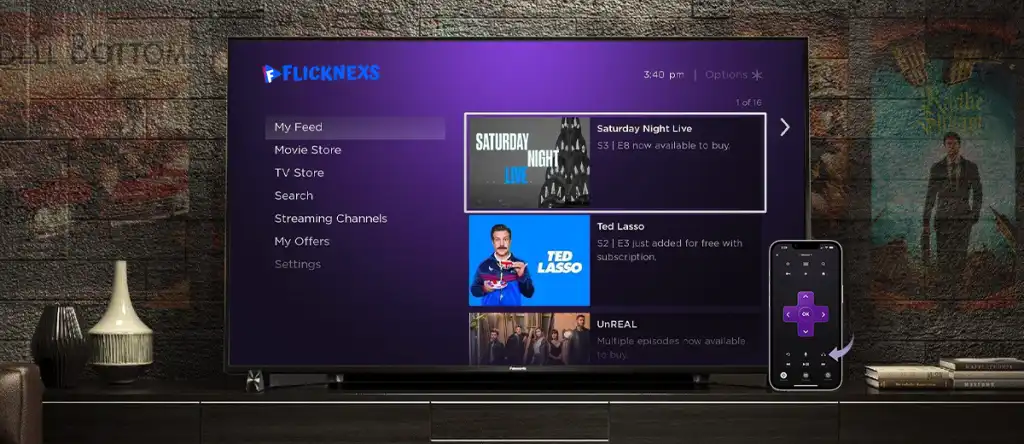In 2025, launching a Roku channel is one of the fastest ways for creators and businesses to reach millions of streaming viewers worldwide. Whether you want to share on-demand videos, live streams, or interactive content, knowing how to start a Roku channel can help you monetize your content, grow your audience, and establish authority in the OTT space.
This guide will walk you through every step from creating a developer account and preparing your content to publishing, monetizing, and promoting your channel so you can launch quickly and professionally.
Quick Summary (TL;DR)
Wondering how to start a Roku channel? This guide explains everything you need to know in 2025:
- Launch via Direct Publisher (fast, no coding) or Custom OTT App (full control, coding required).
- Steps: Create a developer account → Prepare content → Monetize → Publish → Promote.
- Monetization options include ads, subscriptions, or hybrid.
- Using Flicknexs simplifies content management, feed creation, and channel growth.
By following this guide, your Roku channel can reach millions, generate revenue, and establish your brand in the OTT ecosystem.
What is a Roku Channel?
A Roku channel is essentially a streaming app that runs on Roku devices and TVs. Viewers can install your channel from the Roku Channel Store or access it through Roku’s platform. Think of it as your own Netflix-style streaming app, but built specifically for Roku’s ecosystem.
There are two main approaches:
- Roku Direct Publisher: Free and template-based, best for beginners but limited in features.
- Custom Roku Channel App: Built through an OTT provider like Flicknexs, offering branding, monetization, and advanced tools.
Why Launch a Roku Channel in 2025?
Roku continues to grow its market dominance, especially in North America. Here’s why 2025 is the right time to launch:
- Massive Audience Reach → Roku devices are used in 1 out of 3 smart TVs sold in the U.S.
- Low Barrier to Entry → With Direct Publisher, anyone can create a channel.
- Revenue Potential → Creators can monetize via ads, subscriptions, or pay-per-view.
- OTT Market Growth → The global OTT market is projected to surpass $476 billion by 2027.
- Branding Opportunity → A custom Roku app sets your content apart with full control.
What Are the Key Features of Roku Direct Publisher?
Here are the main features that make Roku Direct Publisher attractive to beginners:
- No coding required – Upload your feed, logo, and brand assets, and you’re good to go.
- Fast setup – Launch a basic Roku channel in just a few hours.
- Free to use – No development cost, which is great for testing.
- Roku Ad Revenue Share – You can monetize through Roku’s built-in ad network.
- Basic analytics – See how many people are watching your channel.
Step-by-Step Guide: How to Start a Roku Channel
Step 1: Create a Roku Developer Account
- Go to the Roku Developer Dashboard:
Navigate to developer.roku.com to access Roku’s developer resources. - Sign up for a free developer account:
- Click Sign Up and fill out your details.
- You’ll need a valid email address and a secure password.
- Agree to the developer terms and conditions.
- Why it’s important:
A developer account gives you access to:- Roku’s channel publishing tools
- Direct Publisher and SDK resources
- Channel analytics and reporting
- The ability to test and submit your channel for approval
Pro Tip: Use a professional email associated with your brand for better communication and credibility.
Step 2: Choose Between Direct Publisher or a Custom OTT App
Roku offers two main paths for creating a channel:
Option 1: Direct Publisher (Free, No Coding Required)
- Best for: Beginners or small content creators.
- Advantages:
- Easy setup, no coding required
- Automatic monetization through Roku’s ad network (AVOD)
- Rapid deployment
- Limitations:
- Limited customization and branding
- Only supports advertising revenue (no subscriptions or pay-per-view)
- Design and navigation are fixed by Roku
Option 2: Custom OTT App (via partners like Flicknexs)
- Best for: Businesses, professional content creators, or anyone who wants full control.
- Advantages:
- Full branding and design control
- Advanced monetization: SVOD (subscription), TVOD (pay-per-view), AVOD (ads), or hybrid
- Customizable user interface, content organization, and features
- Considerations:
- Paid service, requires investment
- May need developer assistance or a third-party platform
Pro Tip: Evaluate your content goals and budget carefully. If monetization and branding are priorities, a Custom OTT app is often worth the investment.
Step 3: Prepare Your Content
Before submitting a channel, you need your content ready in the right format.
- Supported video formats:
- MP4 (H.264 video codec, AAC audio codec)
- HLS (HTTP Live Streaming, .m3u8 playlists)
- Metadata preparation:
- Titles: Clear and descriptive
- Descriptions: Concise, engaging, and keyword-rich
- Categories: Helps users find your content
- Thumbnails: High-quality images (preferably 1280×720 px or 1920×1080 px)
- Organize content:
- Use playlists or series to group similar content
- Consider thematic collections for easier navigation
Pro Tip: Well-organized metadata improves discoverability and boosts viewer engagement.
Step 4: Configure Monetization
Monetization options differ depending on your channel type.
- Direct Publisher (Free)
- Monetization is limited to ads through Roku’s AVOD network
- Ads are automatically inserted, no setup required
- Custom OTT App
- Full control over revenue and subscription options
- Monetization options include:
- SVOD (Subscription Video On Demand): Charge users a recurring subscription fee
- TVOD (Transactional Video On Demand): Pay-per-view content
- AVOD (Ad-Supported Video On Demand): Earn revenue from ads
- Hybrid model: Combine subscriptions, ads, and pay-per-view
Pro Tip: Choose a monetization strategy that matches your audience behavior. For example, niche content often performs better with subscriptions, while casual content may earn more through ads.
Step 5: Submit and Publish Your Channel
- Test your channel:
- Use a Roku device or Roku emulator to verify playback, metadata, and UI
- Check video quality and ensure all links and thumbnails display correctly
- Fix errors:
- Ensure all videos play without buffering
- Verify metadata accuracy
- Test monetization and login/subscription workflows
- Submit for review:
- Fill out the channel submission form on Roku Developer Dashboard
- Include all necessary assets and documentation
- Wait for Roku’s approval (usually a few days to a couple of weeks)
- Publish:
- Once approved, your channel will appear in the Roku Channel Store
- Users can add your channel to their Roku home screen
Pro Tip: Use Roku’s Preview Mode to allow beta testers or early users to access your channel before full launch.
Step 6: Promote and Grow Your Audience
Launching a channel is just the beginning. Growth requires consistent promotion and engagement.
- Share your channel:
- Website and blog posts
- Email campaigns
- Social media platforms
- Optimize channel metadata:
- Use SEO-friendly titles, descriptions, and tags
- Highlight trending content or seasonal specials
- Engage your audience:
- Add fresh content regularly
- Respond to viewer feedback
- Consider cross-promotion with other channels or creators
- Track performance:
- Use Roku’s analytics to monitor views, engagement, and revenue
- Adjust content strategy based on performance data
Pro Tip: Consider running promotions or limited-time free content to attract initial viewers.
Optional Step 7: Expand Your Channel Features
Once your channel gains traction, you can enhance user experience by:
- Adding channels or playlists for niche topics
- Implementing interactive features, like polls or quizzes
- Integrating third-party services for analytics or additional monetization
What Are the Differences Between Roku Direct Publisher and Custom OTT Apps?
| Feature | Roku Direct Publisher | Custom Roku App (via Flicknexs) |
|---|---|---|
| Cost | Free | $500 – $10,000+ |
| Coding Required | No | No (done via provider) |
| Branding | Limited templates | Full customization |
| Monetization | Ads only | SVOD, TVOD, AVOD, Hybrid |
| Analytics | Basic | Advanced dashboards |
| Scalability | Limited | Enterprise-ready |
Why Choose Flicknexs for Your Roku Channel?
While Roku Direct Publisher is a good starting point, many creators and businesses eventually need more control, flexibility, and monetization options. That’s where Flicknexs comes in.
Flicknexs is a white-label OTT platform that helps you build a fully customized Roku channel without coding. Unlike the limitations of Direct Publisher, Flicknexs allows you to:
- Launch a branded Roku channel with your own logo and design.
- Monetize using SVOD, AVOD, TVOD, or Hybrid models.
- Access advanced analytics to track viewer engagement and revenue.
- Scale across devices — not just Roku, but also Fire TV, Apple TV, Android TV, Web, and Mobile apps.
- Get end-to-end support from content upload to app publishing.
By choosing Flicknexs, you future-proof your Roku channel and create a sustainable streaming business with global reach.
What Are the Best Monetization Models for Roku Channels?
- SVOD (Subscription Video on Demand)
- Example: Monthly subscription like Netflix.
- Great for consistent revenue.
- AVOD (Advertising Video on Demand)
- Example: Free channels supported by ads.
- Best for reaching wider audiences.
- TVOD (Transactional Video on Demand)
- Example: Pay-per-view movies or events.
- Works for exclusive or premium content.
- Hybrid Model
- Combine subscriptions + ads for maximum flexibility.
- Example: Free ad-supported tier + premium subscription.
How Can You Rank Your Roku Channel Higher in the Store?
- Use keyword-rich titles and descriptions.
- Upload high-quality thumbnails and images.
- Categorize your channel correctly for discoverability.
- Update your channel with new content consistently.
- Collect reviews and ratings to boost trust.
Conclusion
Launching a Roku channel in 2025 is one of the smartest moves for creators and businesses looking to scale in the OTT space. Whether you choose Roku Direct Publisher for a free start or a custom Roku app via Flicknexs for advanced features, you can build a channel that reaches millions of viewers and generates real revenue.
Ready to build your own Roku channel? Start your free trial with Flicknexs today and unlock the full potential of OTT streaming.



Leave a Reply